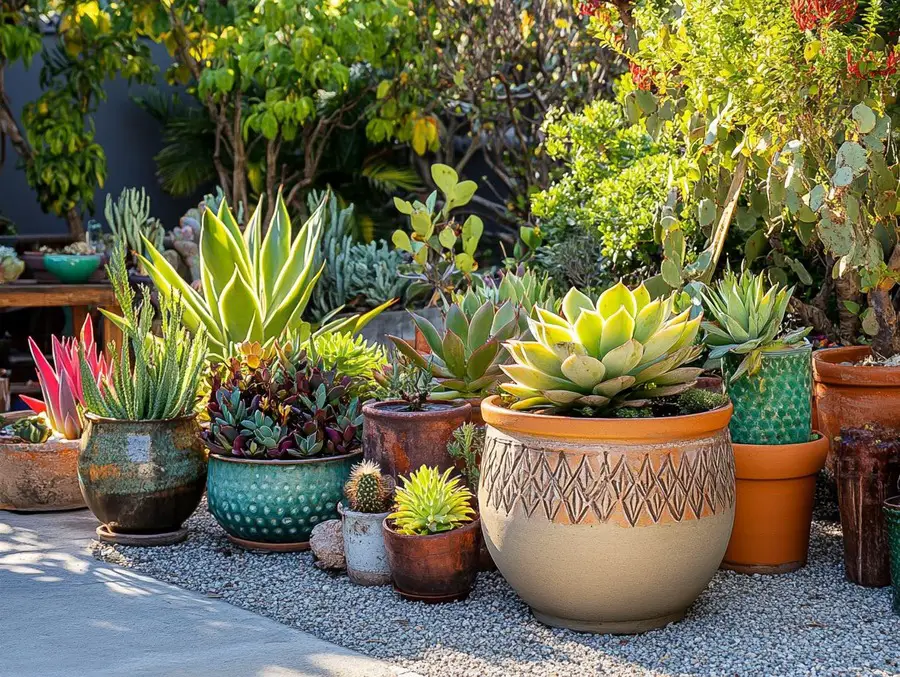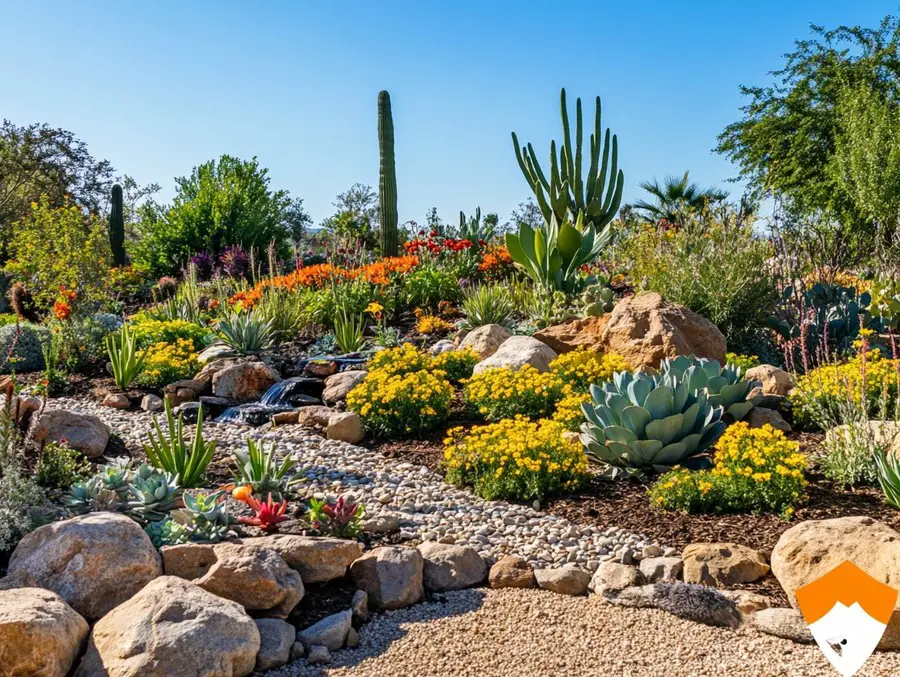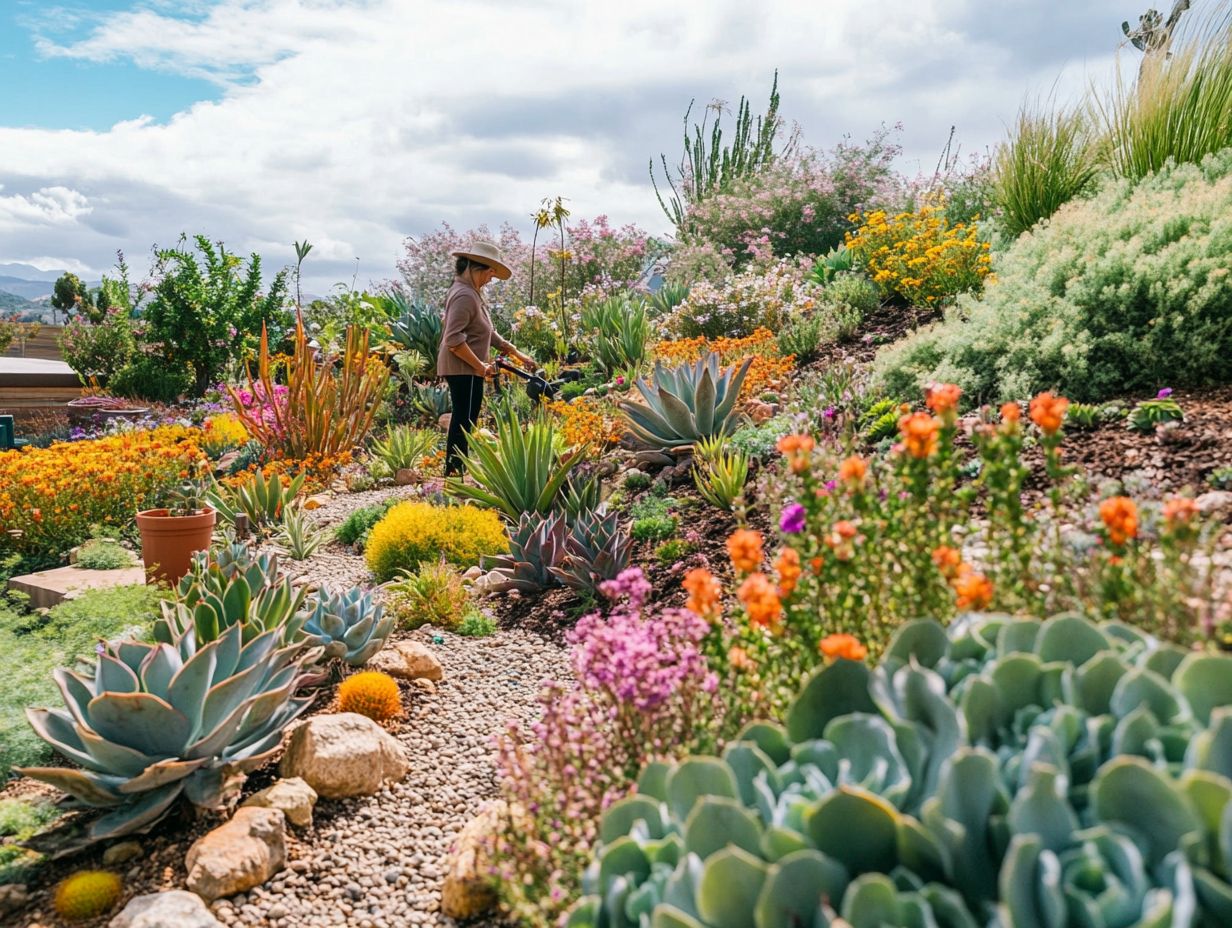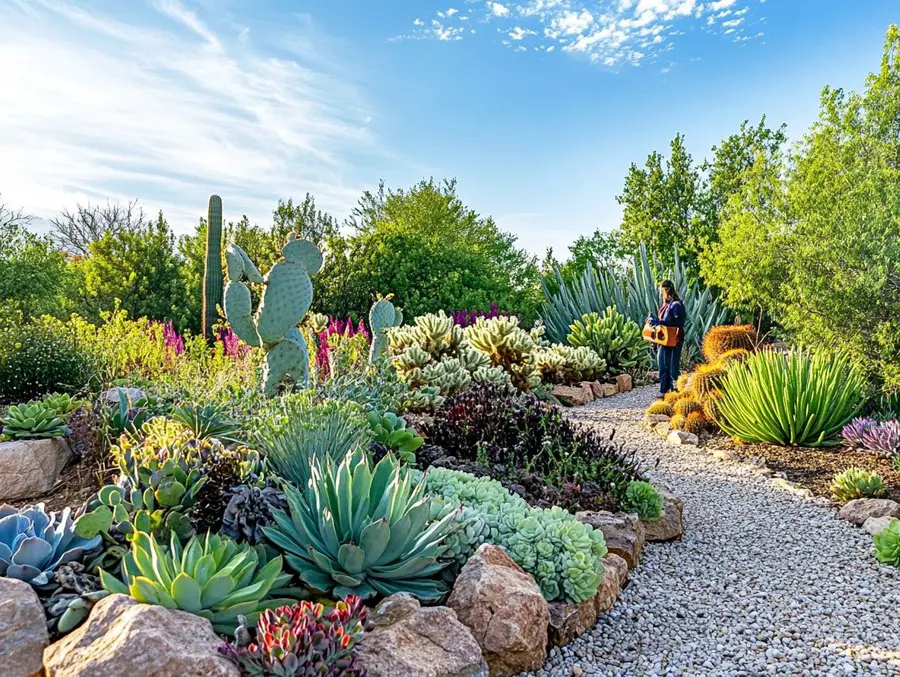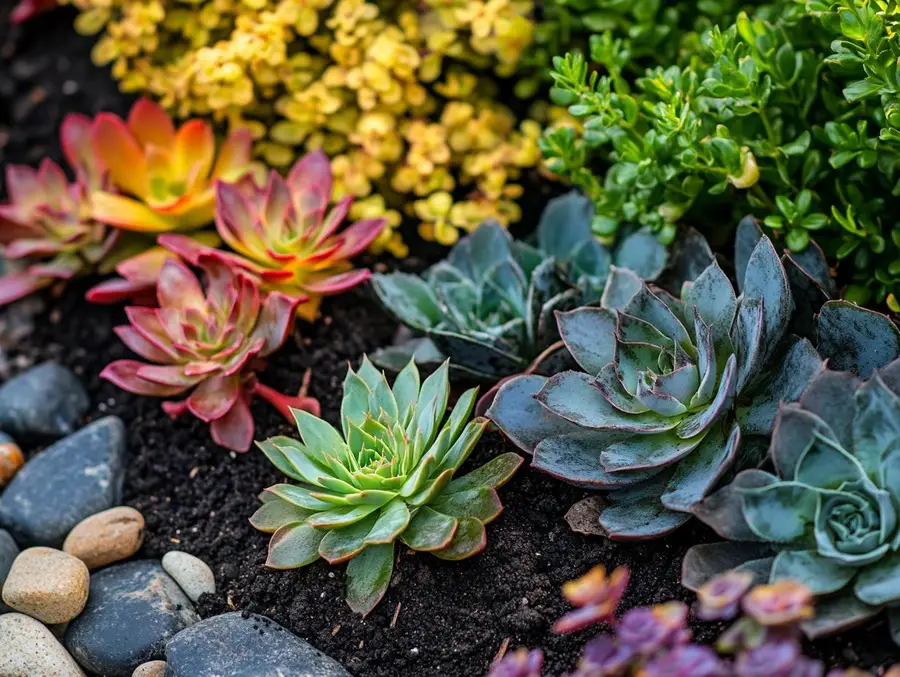We use affiliate links. If you purchase something using one of these links, we may receive compensation or commission.
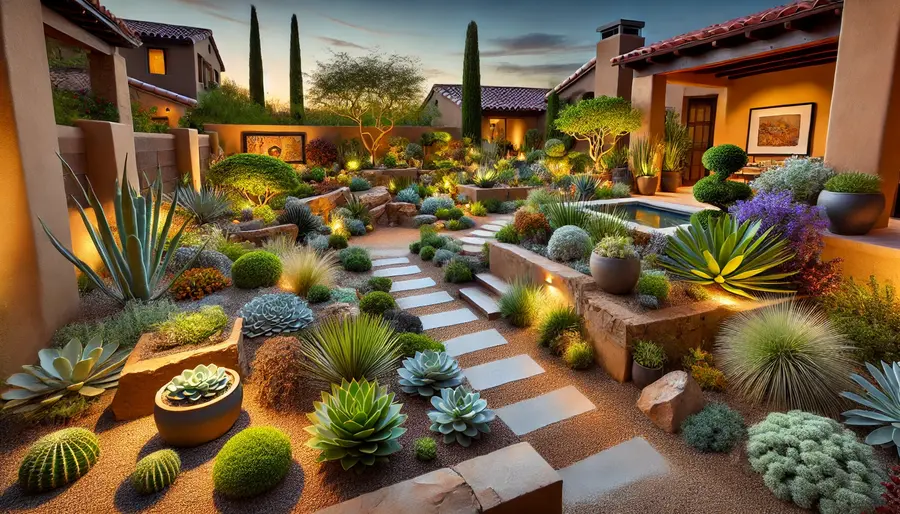 Xeriscape Garden Styles make it easy to create a beautiful, water-saving yard without sacrificing design.
Xeriscape Garden Styles make it easy to create a beautiful, water-saving yard without sacrificing design.
Tired of high water bills and constant yard work? A xeriscape garden can be lush, colorful, and easy to maintain with the right style and plant choices.
Let’s explore the best styles and locations for a stunning, low-water yard.
Xeriscape Garden Styles Key Takeaways
- Xeriscape Garden Styles focuses on water-efficient, low-maintenance designs that thrive in dry climates.
- Popular styles include desert-inspired rock gardens, Mediterranean courtyards, and lush native plant designs.
- By combining drought-resistant plants, gravel, and smart irrigation, these gardens provide beauty without the high water bills.
1. What Defines a Xeriscape Garden Style?
Xeriscape gardens aren’t just about saving water—they can be bold, colorful, and designed to fit any personal style.
Whether you love the look of desert-inspired landscapes, Mediterranean courtyards, or lush native plant designs, a xeriscape can be shaped to match your vision while staying low-maintenance and water-wise.
But what really makes a xeriscape garden stand out? Let’s break it down.
Core Features of a Xeriscape Garden Style
While each xeriscape style is different, the most successful designs include:
✅ Drought-Tolerant Plants
- Succulents, cacti, native perennials, and ornamental grasses thrive with minimal water.
- Grouping plants by water needs (hydrozoning) keeps irrigation efficient.
✅ Ground Cover Alternatives to Grass
- Gravel, mulch, and drought-friendly ground covers reduce water loss.
- Options like creeping thyme, sedum, or decomposed granite add texture while staying low-maintenance.
✅ Hardscaping for Structure & Contrast
- Patios, walkways, and decorative boulders define spaces and reduce the need for plants.
- Raised beds, terracing, and dry creek beds add dimension and function.
✅ Smart Watering Systems
- Drip irrigation and rainwater collection make the most of available moisture.
- Swales and permeable pathways help water soak into the ground instead of running off.
✅ Seasonal Interest & Wildlife Benefits
- Flowering perennials like salvia, yarrow, and penstemon attract pollinators.
- Ornamental grasses and evergreen shrubs keep the garden visually appealing all year.
📌 Pro Tip: Start with a basic framework—hardscape first, then major plants, and finish with ground covers and de
🔗 Related Read: The 7 Principles of Xeriscaping
Choosing the Right Style for Your Climate & Space
Not every xeriscape style works in every location. Here’s how to match your garden style to your climate:
🌵 Hot, Dry Climates (Arizona, Texas, Nevada) – Desert xeriscapes with cacti, gravel, and boulders work best.
🌿 Mild Coastal Climates (California, Mediterranean Regions) – Mediterranean-style xeriscapes thrive with lavender, olive trees, and decomposed granite paths.
🏡 Urban & Small Yards (Apartments, Rooftops, Courtyards) – Compact xeriscapes with container gardens, vertical plant walls, and succulents fit small spaces.
🌲 Cooler, High-Altitude Climates (Colorado, Northern U.S.) – Native plant xeriscapes with low-water perennials, grasses, and shrubs create a lush look with minimal irrigation.
📌 Pro Tip: Research local plant lists to find xeric plants that thrive naturally in your region—they’ll need less care and water.
🔗 Related Read: Xeriscaping for Different Climates
Why Xeriscape Styles Work for Every Yard
A xeriscape isn’t one-size-fits-all—it’s a customizable way to design a yard that fits your space, climate, and personal taste.
By choosing the right plants, ground covers, and hardscaping, you can create a garden that is both practical and visually stunning.
2. Desert-Inspired Xeriscape Gardens
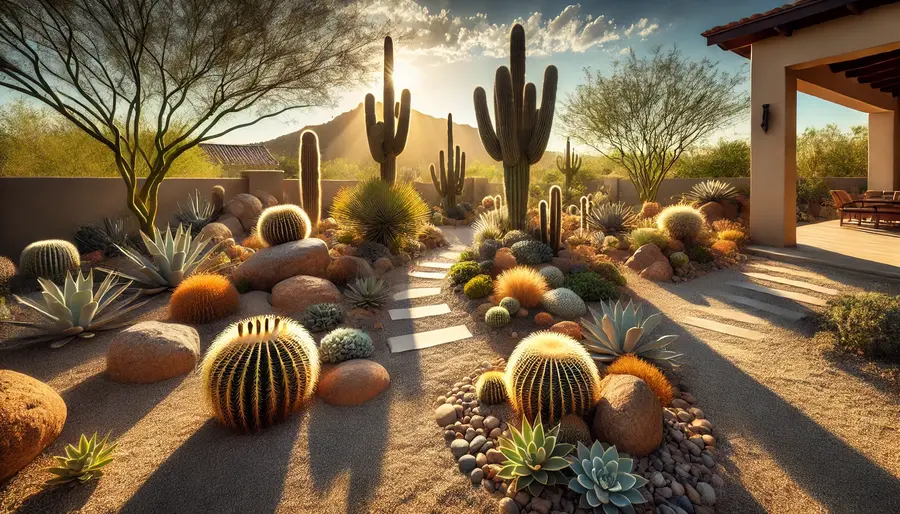
If you love clean lines, bold plant shapes, and a minimalist approach, a desert xeriscape is a perfect choice.
This style mimics the natural beauty of arid landscapes while staying low-maintenance and water-efficient.
With the right mix of succulents, cacti, and decorative rocks, you can create a space that feels both serene and striking.
Let’s look at how to bring a desert-inspired xeriscape to life.
Key Features of a Desert Xeriscape
Desert-inspired gardens focus on earthy tones, sculptural plants, and natural materials. Here’s what makes them unique:
✅ Cacti & Succulents as Focal Points
- Tall, columnar cacti like saguaro or Mexican fence post cactus add structure.
- Agave, aloe, and yucca create a bold, architectural look.
- Low-growing succulents like golden barrel cactus and stonecrop sedum fill in gaps.
✅ Gravel, Sand & Rock Ground Cover
- Replaces traditional grass with crushed granite, river rock, or desert sand.
- Helps prevent soil erosion and allows for proper drainage.
- Contrasts with lush green succulents and cacti for a natural balance.
✅ Decorative Boulders & Hardscaping
- Large boulders act as focal points and add a natural touch.
- Stepping stone pathways help guide movement through the space.
- Raised rock beds or retaining walls create depth and prevent runoff.
✅ Low-Water Flowering Plants for Seasonal Color
- Red Yucca (Hesperaloe parviflora) – Tall flower spikes attract hummingbirds.
- Penstemon – Vibrant pink and purple flowers bloom in early spring.
- Desert Marigold – Bright yellow blooms contrast against gravel and rock.
📌 Pro Tip: Use light-colored gravel or stone to reflect heat and keep the area cooler in hot weather.
🔗 Related Read: Succulents for Xeriscaping
How to Design a Desert-Inspired Xeriscape
Creating a desert xeriscape is all about balance—too many rocks can make it feel barren, while too many plants can take away from the clean, open look.
🌵 Start with large plants first – Position cacti, yuccas, or agaves as anchors.
🪨 Add boulders or rock formations – Space them naturally to create flow.
🌿 Fill in with smaller succulents & drought-tolerant flowers – Choose plants with varied textures and heights.
🌞 Use gravel, sand, or decomposed granite – Covers the soil while allowing rainwater to drain properly.
🏡 Include seating areas – A stone bench or sun-shaded patio makes the space more inviting.
📌 Pro Tip: Group plants in odd-numbered clusters (3, 5, or 7) to create a natural, balanced look.
🔗 Related Read: Hardscaping in Xeriscape Design
🔗 Related Read: Xeriscaping for Slopes and Hillsidess
Why Desert Xeriscapes Are a Smart Choice
A desert xeriscape is one of the lowest-maintenance styles you can create.
It’s ideal for hot, arid climates but can work in any region with the right plant choices.
✅ Requires almost no watering – Perfect for areas with strict water restrictions.
✅ Minimal upkeep – No mowing, pruning, or replanting every season.
✅ Adds instant curb appeal – Modern, clean, and visually striking.
3. Mediterranean Xeriscape Gardens
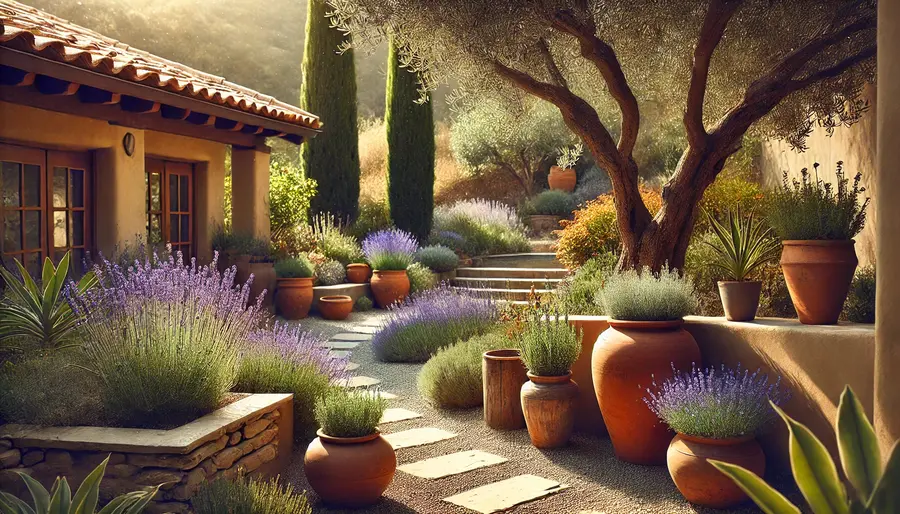
If you love warm, earthy tones, fragrant herbs, and a relaxed outdoor feel, a Mediterranean xeriscape is a perfect choice.
Inspired by the gardens of Italy, Greece, and Spain, this style blends drought-tolerant plants, stone pathways, and shaded courtyards to create a timeless, inviting space.
Whether you want a cozy retreat or an elegant front yard, a Mediterranean xeriscape brings beauty and function with minimal upkeep.
Key Features of a Mediterranean Xeriscape
Mediterranean-style xeriscapes combine structured hardscaping with soft, flowing plants for a natural but refined look.
✅ Drought-Tolerant Trees & Shrubs for Shade
- Olive trees – Evergreen, with silvery-green leaves and a classic Mediterranean feel.
- Italian cypress – Tall and narrow, perfect for creating structure or privacy.
- Lavender and rosemary – Fragrant, low-water shrubs that add softness and scent.
✅ Terracotta, Stone, & Gravel Elements
- Decomposed granite or gravel pathways replace traditional grass.
- Terracotta pots filled with succulents or herbs add warmth and character.
- Stone walls and decorative tiles enhance the Mediterranean feel.
✅ Flowering Plants for Seasonal Color
- Bougainvillea – Bright pink, purple, or red flowers add a bold pop of color.
- Salvia and yarrow – Drought-friendly flowers that attract pollinators.
- Rockrose (Cistus) – Low-growing shrub with delicate blooms and evergreen leaves.
✅ Shaded Seating Areas for Outdoor Living
- Pergolas or vine-covered trellises create cool, shaded spaces.
- Built-in stone benches blend seamlessly with natural elements.
- Fountains or birdbaths add a refreshing water feature without wasting water.
📌 Pro Tip: Mediterranean xeriscapes use warm, natural colors—stick with earthy reds, yellows, and creams for hardscaping materials.
🔗 Related Read: Best Plants for Xeriscaping
How to Design a Mediterranean Xeriscape
A Mediterranean xeriscape should feel relaxed, welcoming, and low-maintenance. Here’s how to get the look:
🏡 Start with a hardscape base – Use stone patios, gravel paths, or decomposed granite to define spaces.
🌿 Choose plants with soft, natural movement – Herbs, grasses, and flowering perennials keep the space lively.
🪵 Add rustic materials – Use wood, wrought iron, and terracotta for planters and décor.
🌞 Create a shady retreat – Pergolas, climbing vines, and olive trees provide cool, shaded seating areas.
🪨 Use natural borders – Stone edging or low rock walls help separate garden beds.
📌 Pro Tip: Plant lavender and rosemary near pathways so you can enjoy their scent as you walk by.
🔗 Related Read: Hardscaping in Xeriscape Design
Why Mediterranean Xeriscapes Work in Many Climates
This style is perfect for hot, dry regions, but it can also work in mild coastal and temperate areas with the right plant choices.
✅ Uses plants that thrive in full sun – Perfect for regions with hot summers and mild winters.
✅ Reduces water use – Mediterranean plants are naturally drought-tolerant.
✅ Encourages outdoor living – Designed for relaxation, dining, and enjoying nature.
4. Native Plant Xeriscape Gardens
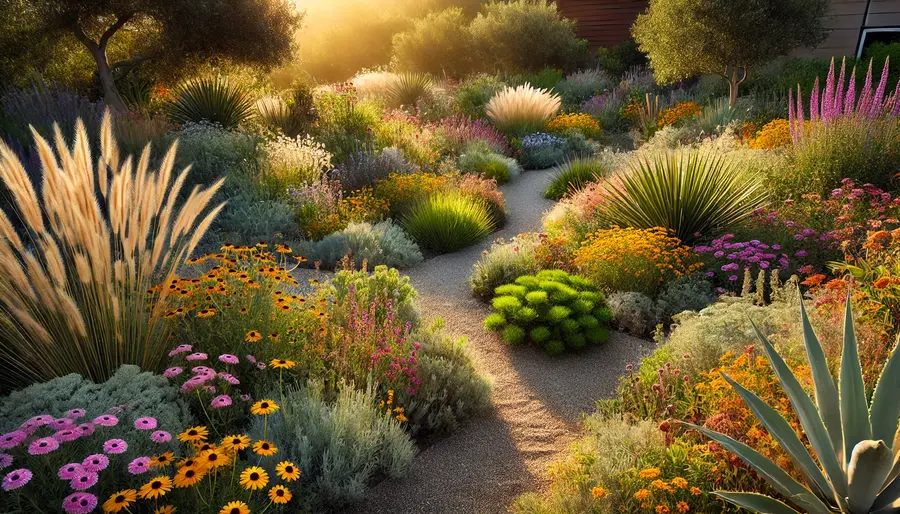
If you want a xeriscape that feels natural, blends into the environment, and requires little upkeep, a native plant xeriscape is the way to go.
By choosing plants that naturally thrive in your region, you’ll create a garden that uses less water, supports wildlife, and stays healthy year-round—without constant maintenance.
Native plant xeriscapes are low-effort, eco-friendly, and full of life. Let’s explore how to design one for your space.
Key Features of a Native Plant Xeriscape
Native xeriscapes focus on regional plants that have adapted to survive without extra care.
These gardens are perfect for homeowners who want a low-maintenance, water-wise yard that benefits the local ecosystem.
✅ Drought-Adapted Plants That Thrive Naturally
- Yarrow – Feathery leaves and colorful blooms that attract pollinators.
- Desert Marigold – Bright yellow flowers that handle extreme heat.
- Purple Coneflower (Echinacea) – Hardy and long-blooming, great for bees and butterflies.
- Wild Grasses (Little Bluestem, Buffalo Grass) – Thrive in tough soils with minimal watering.
✅ Supports Local Pollinators & Wildlife
- Milkweed attracts monarch butterflies, providing a habitat for caterpillars.
- Salvia and Penstemon bring hummingbirds into the yard.
- Native grasses and shrubs give shelter to birds and beneficial insects.
✅ Works with the Natural Environment
- No need for fertilizers or pesticides—native plants thrive on their own.
- Grows well in local soil without heavy amendments.
- Resists common pests and diseases found in the region.
📌 Pro Tip: Native plants naturally adjust to seasonal weather changes, making them a reliable choice for year-round color and structure.
🔗 Related Read: Native Plants for Xeriscaping
How to Design a Native Plant Xeriscape
The best way to build a native xeriscape is to work with what you have.
Instead of forcing an unnatural look, let local plants and natural materials guide your design.
🌿 Choose plants that already grow well in your area – Look at local parks, nature trails, or native plant nurseries for inspiration.
🪨 Use natural materials – Replace grass with decomposed granite, wood mulch, or local stone.
🌞 Group plants by sun and water needs – Shade-loving plants go under trees, drought-tolerant ones thrive in full sun.
💧 Capture rainwater naturally – Use dry creek beds, rain barrels, or swales to direct water to thirsty plants.
🏡 Create natural borders – Use wild grasses, flowering perennials, or shrubs to define pathways and garden beds.
📌 Pro Tip: Avoid invasive species—some non-native plants may survive in your area but can spread aggressively and harm local ecosystems.
🔗 Related Read: Xeriscaping for Wildlife Habitats
Why Native Plant Xeriscapes Are a Smart Choice
By using plants that have already adapted to your climate, a native xeriscape is one of the easiest, most sustainable gardens to maintain.
✅ Saves water – Native plants require little to no irrigation once established.
✅ Thrives without extra care – No fertilizers, pesticides, or heavy pruning needed.
✅ Creates a balanced ecosystem – Provides habitat for local birds, bees, and butterflies.
5. Contemporary & Minimalist Xeriscape Gardens
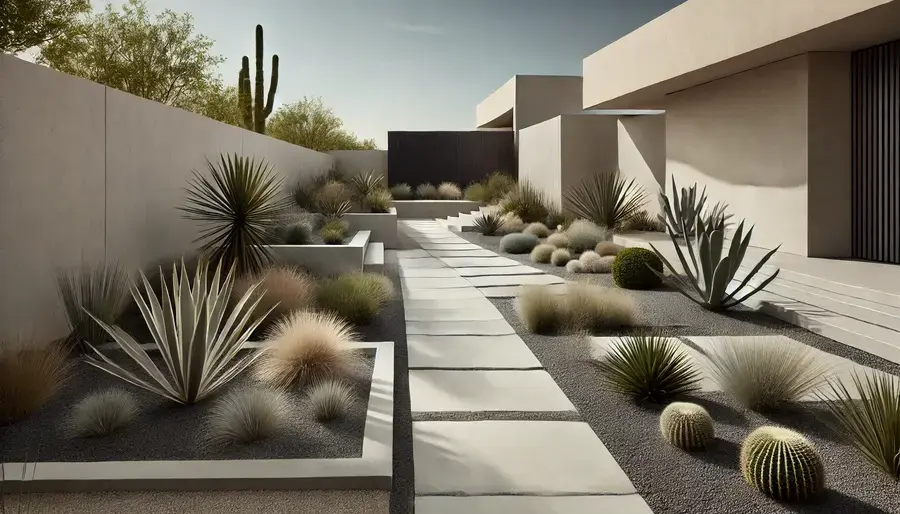
If you love clean lines, structured plantings, and a sleek modern look, a contemporary xeriscape is the perfect fit.
This style blends low-maintenance, drought-tolerant plants with geometric hardscaping and open space to create a garden that is simple, stylish, and incredibly easy to care for.
Minimalist xeriscapes are great for small yards, modern homes, and those who want beauty without the extra work.
Let’s explore how to achieve this sleek, water-efficient design.
Key Features of a Contemporary Xeriscape
Minimalist xeriscapes focus on balance, symmetry, and simplicity while keeping maintenance low.
✅ Geometric Layouts & Defined Spaces
- Straight-edged paved walkways, stone slabs, or concrete paths for a structured look.
- Gravel beds or decomposed granite instead of grass for a clean, open feel.
- Use of rectangular planters, raised beds, or tiered sections to add height and depth.
✅ Drought-Tolerant Plants with Simple Shapes
- Yucca and agave – Sharp, structural plants that create strong focal points.
- Ornamental grasses – Soft texture contrasts with hardscape materials.
- Succulents (Aloe, Echeveria, Stonecrop Sedum) – Low-growing, clean-lined plants that thrive in dry conditions.
✅ Neutral Color Palettes & Contrasting Textures
- Gray, white, or black gravel for a sleek, modern feel.
- Polished concrete, metal planters, or smooth stone to contrast with organic shapes.
- Use of repeating plant patterns for visual consistency.
📌 Pro Tip: Keep plant selection simple and intentional—too many different species can make the space feel cluttered.
🔗 Related Read: Hardscaping in Xeriscape Design
How to Design a Minimalist Xeriscape
A contemporary xeriscape is all about intentional placement, balance, and simplicity. Here’s how to make it work:
🏡 Define main spaces first – Create clear walkways, seating areas, and planting beds before adding plants.
🪵 Use repetition in plants and materials – A row of identical succulents looks cleaner than a mix of different species.
🪨 Stick to a limited color palette – Grays, whites, and greens keep the space modern.
🌞 Choose drought-tolerant plants with strong shapes – Agave, yucca, and aloe vera fit perfectly.
🪑 Incorporate modern hardscaping – Concrete patios, sleek wooden benches, or minimalist water features add style.
📌 Pro Tip: Use lighting strategically—soft LED ground lights can highlight pathways or focal plants at night.
🔗 Related Read: Xeriscaping for Small Spaces
Why Minimalist Xeriscapes Are a Smart Choice
If you prefer modern, stylish gardens with almost no upkeep, a minimalist xeriscape is the way to go.
✅ Low-maintenance – Less planting, pruning, and watering.
✅ Water-efficient – Gravel and stone replace thirsty grass.
✅ Perfect for urban & small yards – Works well in tiny courtyards, patios, or rooftops.
6. Urban & Small-Space Xeriscaping
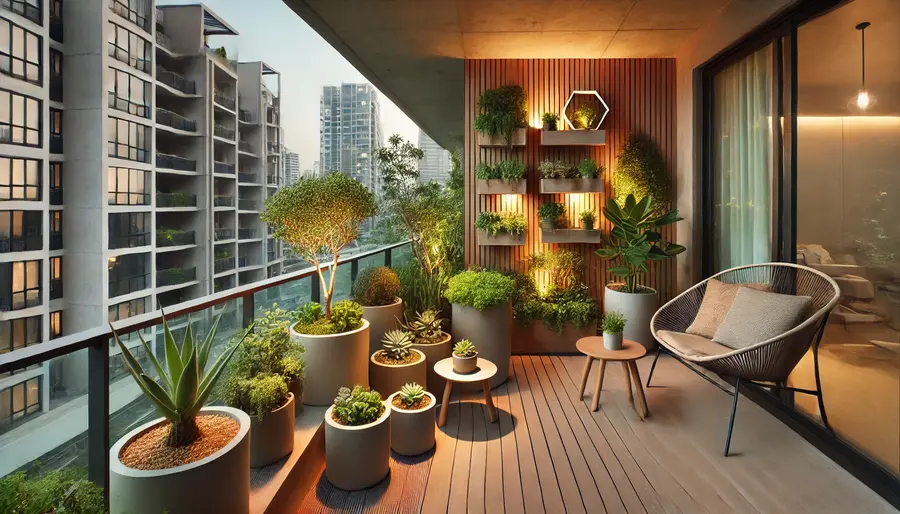
Even if you don’t have a large yard, you can still create a beautiful, low-water xeriscape in a small space, patio, or balcony.
Urban xeriscaping focuses on compact, space-saving designs that bring nature into city environments without requiring heavy maintenance or watering.
If you want a functional, stylish, and water-efficient garden in a small space, this approach is perfect for you.
Key Features of Urban & Small-Space Xeriscaping
Urban xeriscapes prioritize space efficiency, container gardening, and vertical elements to maximize impact in limited areas.
✅ Drought-Tolerant Container Gardens
- Succulents, cacti, and herbs thrive in pots with minimal watering.
- Terracotta, metal, or concrete planters add a modern touch.
- Grouped containers create a lush look while keeping plants easy to move and rearrange.
✅ Vertical Gardens & Wall Planters
- Mounted succulent walls bring greenery to balconies and patios.
- Trellises with drought-tolerant vines (like jasmine or bougainvillea) create privacy.
- Hanging baskets with low-water plants add height and depth.
✅ Hardscaping for Multi-Use Spaces
- Gravel, pavers, or decking instead of grass for a clean, modern foundation.
- Built-in seating or benches with planters to maximize functionality.
- Small water features (like a tabletop fountain) for ambiance without excessive water use.
✅ Microclimate Awareness
- Reflective heat from walls and pavement can dry plants faster—use shade-tolerant succulents in hot spots.
- Rain collection barrels or self-watering pots help keep plants hydrated efficiently.
📌 Pro Tip: Use self-watering planters or drip irrigation to keep maintenance minimal while ensuring plants get what they need.
🔗 Related Read: Xeriscaping for Apartment Balconies
🔗 Related Read: Fast-Growing Plants for Xeriscaping
How to Design a Small-Space Xeriscape
A small-space xeriscape should feel intentional and functional and every plant and element should have a purpose.
🏡 Maximize vertical space – Use hanging planters, shelves, or mounted pots to make the most of the walls.
🌵 Choose compact drought-tolerant plants – Small succulents, dwarf grasses, and Mediterranean herbs are perfect.
🪨 Use gravel, pavers, or decking – Avoid traditional grass to keep maintenance low.
🪑 Incorporate multi-use hardscaping – Built-in seating with planters, stacked stone walls, or decorative pottery help save space.
🌞 Position plants by sun exposure – Use shade-loving plants in darker areas and sun-lovers near open balconies.
📌 Pro Tip: Use light-colored gravel or pavers to reflect heat and keep small patios or balconies cooler.
🔗 Related Read: Best Plants for Small Xeriscapes
Why Urban Xeriscapes Are a Smart Choice
If you live in a city, condo, or small home, xeriscaping lets you bring nature into your space without adding extra work.
✅ Works for any size space – Great for balconies, rooftops, courtyards, or patios.
✅ Low-maintenance, high impact – Even a few potted succulents can make a big difference.
✅ Eco-friendly & sustainable – Saves water, reduces heat buildup, and attracts pollinators.
7. Best Locations for a Xeriscape Garden
Xeriscaping isn’t just for desert climates.
It works in many different environments with the right plant selection.
Whether you live in a hot, dry area or want to reduce water use in a coastal, suburban, or urban setting, a xeriscape can be customized to fit your space and climate.
Let’s explore the best places to create a water-wise, low-maintenance garden.
Where Xeriscaping Works Best
✅ Hot, Arid Climates (Deserts & Dry Regions)
- Perfect for cacti, succulents, desert wildflowers, and gravel-based designs.
- Works well with rock gardens, dry creek beds, and boulders.
- Requires minimal irrigation once plants are established.
✅ Coastal Climates (California, Mediterranean Regions)
- Thrives with salt-tolerant plants like sea lavender and sedum.
- Uses decomposed granite pathways and drought-friendly shrubs for a natural look.
- Benefits from warm temperatures and occasional rain, reducing the need for irrigation.
✅ Suburban Lawns & Front Yards
- Great alternative to traditional grass lawns.
- Works well with flowering perennials, ornamental grasses, and shade trees.
- Reduces mowing, watering, and maintenance costs while keeping curb appeal high.
✅ Urban & Small Spaces (Balconies, Rooftops, Courtyards)
- Uses potted succulents, vertical gardens, and drought-friendly container plants.
- Incorporates modern hardscaping, water-efficient irrigation, and shade structures.
- Ideal for low-maintenance living in apartments or city homes.
✅ Mountain & High Desert Climates
- Adapts to cooler temperatures with native grasses and evergreen shrubs.
- Uses rock mulch, rain-catching basins, and wind-resistant plants.
- Handles temperature swings and occasional snowfall with hardy perennials.
📌 Pro Tip: Even in wetter climates, xeriscaping reduces water waste and prevents erosion, making it a smart choice for any region.
🔗 Related Read: Xeriscaping for Different Climates
How to Choose the Right Xeriscape for Your Location
No matter where you live, a xeriscape can be customized to your climate and space with these simple steps:
🌍 Check your USDA Hardiness Zone – Find plants that thrive in your specific region.
🌧 Assess rainfall & soil type – Choose plants that match your natural moisture levels.
🌞 Consider sun exposure – Place shade-tolerant plants under trees or near buildings.
🪨 Use local materials – Gravel, rocks, and soil that naturally occur in your area will blend in better and require less upkeep.
📌 Pro Tip: Native plants are always a smart choice—they’re already adapted to your climate, meaning less maintenance and higher success rates.
🔗 Related Read: Native Plants for Xeriscaping
🔗 Related Read: Fire-Resistant Xeriscaping Plants
Why Xeriscaping Works in Any Location
Xeriscaping isn’t just a trend for dry regions.
It’s a sustainable, cost-saving way to garden anywhere.
Whether you live in a hot desert, humid coast, suburban neighborhood, or busy city, a xeriscape can reduce maintenance, cut water costs, and look beautiful year-round.
✅ Works in all climates – Just select the right plants and materials for your area.
✅ Reduces water use – Cuts irrigation needs by 50-75% compared to traditional gardens.
✅ Eco-friendly & sustainable – Supports pollinators, prevents runoff, and conserves resources.
Xeric Gardens Offer Endless Possibilities
Xeriscape Garden Styles offer endless possibilities for designing a stunning, low-water yard.
Whether you love desert simplicity, Mediterranean warmth, or a modern, structured look, there’s a style for every taste and space.
8. Bringing It All Together
Xeriscape gardens aren’t just practical and they can be stunning, low-maintenance, and full of life.
Whether you prefer a desert-inspired look, a lush Mediterranean feel, or a structured modern design, xeriscaping works in any space and climate with the right plant and material choices.
If you want a yard that saves water, reduces maintenance, and stays beautiful year-round, now is the perfect time to start planning your xeriscape.
How to Get Started with Your Xeriscape Garden
Creating a successful xeriscape is about choosing the right plants, materials, and layout to match your space and climate.
🌱 Pick a style that fits your space – Whether it’s desert, Mediterranean, modern, or native, find a look that works for you.
🪨 Use hardscaping to define spaces – Gravel, rocks, and pathways keep the garden structured and functional.
🌿 Choose drought-tolerant plants – Go for succulents, ornamental grasses, native perennials, and low-water shrubs.
💧 Plan for efficient watering – Use drip irrigation, rainwater harvesting, or dry creek beds to make the most of every drop.
🏡 Think about long-term maintenance – The best xeriscapes look great year after year with minimal care.
📌 Pro Tip: Start small—xeriscaping doesn’t have to be an all-or-nothing project. Begin with one section of your yard and expand over time.
🔗 Related Read: Budget-Friendly Xeriscaping for Beginners
🔗 Related Read: Coastal Plants for Xeriscaping
Why Xeriscape Gardens Are the Future of Sustainable Landscaping
Xeriscaping is more than just a way to save water, it’s a smart, sustainable way to garden that helps you spend less time maintaining your yard and more time enjoying it.
✅ Cuts water use by 50-75% – Perfect for dry climates and areas with water restrictions.
✅ Low-maintenance design – Less watering, no mowing, and fewer weeds.
✅ Visually stunning – With the right plant choices, a xeriscape is just as lush and colorful as a traditional garden.
✅ Supports pollinators & wildlife – Many xeric plants attract bees, butterflies, and hummingbirds.
FAQ Section: Xeriscape Garden Styles
Xeriscaping offers stunning, low-maintenance gardens without wasting water.
If you’re wondering how to choose the right xeriscape style or what plants work best, here are some quick answers to common questions.
Q: What are the different styles of xeriscape gardens?
A: Xeriscape gardens come in many styles, including desert-inspired, Mediterranean, native plant gardens, modern minimalist, and urban small-space designs.
Each style uses drought-tolerant plants, hardscaping, and efficient irrigation to reduce water use while keeping your yard beautiful.
Q: How do I choose the best xeriscape style for my yard?
A: The best xeriscape style depends on your climate, space, and personal taste. Desert styles work well in hot, dry areas, while Mediterranean gardens thrive in warm coastal climates.
Native plant xeriscapes blend naturally into their surroundings, and modern xeriscapes create a sleek, structured look.
Q: Do xeriscape gardens have to look like a desert?
A: No! While desert xeriscapes use cacti, gravel, and rocks, many other styles include lush perennials, flowering plants, ornamental grasses, and shade trees.
A xeriscape can be colorful, textured, and inviting while still being water-efficient.
Q: What are the best plants for a xeriscape garden?
A: The best plants for xeriscaping are drought-tolerant and adapted to your climate. Some great options include:
- Perennials: Yarrow, salvia, black-eyed Susan, lavender
- Succulents & Cacti: Agave, aloe vera, prickly pear cactus, sedum
- Ornamental Grasses: Blue fescue, fountain grass, little bluestem
- Shrubs & Trees: Texas sage, rosemary, olive tree, mesquite
🔗 Related Read: Best Plants for Xeriscaping
Q: Can I xeriscape a small yard or urban space?
A: Absolutely! Xeriscaping works in balconies, patios, courtyards, and even rooftops.
Use container gardens, vertical planters, and compact drought-tolerant plants like succulents, herbs, and dwarf grasses.
Hardscaping, such as gravel paths or stone seating areas, keeps small spaces looking clean and functional.
🔗 Related Read: Xeriscaping for Small Spaces
Q: Do xeriscape gardens need irrigation?
A: Most xeriscape plants need some watering in their first year to establish strong roots.
After that, many thrive on rainfall alone or occasional deep watering.
Using drip irrigation, rain barrels, or dry creek beds can help maximize water efficiency.
Q: What are the best ground cover alternatives for xeriscaping?
A: Instead of traditional grass, xeriscapes use low-water ground covers like:
- Creeping thyme – Fragrant and great between stepping stones.
- Ice plant – Colorful flowers and thick, water-storing leaves.
- Blue star creeper – Soft, low-growing greenery.
- Drought-tolerant sedum – Spreads quickly with almost no care.
🔗 Related Read: Best Ground Covers for Xeriscaping
Q: Can I add shade to a xeriscape garden?
A: Yes! Many drought-tolerant trees and shrubs provide shade while using minimal water.
Great choices include:
- Desert willow – Light, airy shade with pink blooms.
- Palo verde – Green bark and filtered shade.
- Olive tree (non-fruiting) – Classic Mediterranean look.
- Texas sage – Compact, drought-hardy shrub with purple flowers.
🔗 Related Read: Best Trees for Xeriscaping
Q: How do I keep my xeriscape garden looking good year-round?
A: Xeriscaping can be colorful and full of life all year with the right plant mix.
Here’s how to keep it thriving:
- Use evergreen shrubs for structure in winter.
- Mix perennials and ornamental grasses for seasonal color.
- Add flowering plants that bloom in different seasons to keep things interesting.
- Apply gravel or mulch to maintain moisture and prevent weeds.
📌 Pro Tip: Deadheading flowers and trimming grasses in early spring keeps the garden fresh.
Q: Can xeriscaping increase property value?
A: Yes! A well-designed xeriscape boosts curb appeal, reduces maintenance costs, and lowers water bills.
Buyers are increasingly interested in eco-friendly, sustainable landscaping that saves time and resources.
Xeriscape Garden Design & Layout: Easy Water-Wise Beauty
Xeriscape Garden Design & Layout: Easy Water-Wise Beauty
Xeriscape Gardening Techniques: Easy Low-Water Tips
What is xeriscaping? A beginner’s guide to drought-tolerant landscaping – Colorado State University
Related Content
Visit my Amazon Influencer Page for videos and gardening products Grow Your Own Garden

